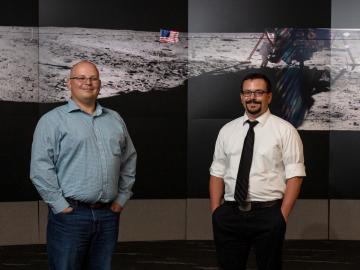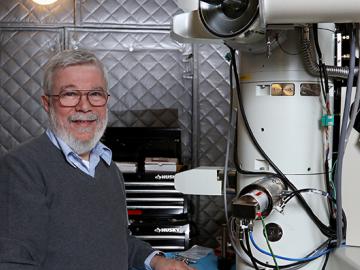
Filter News
Area of Research
- Advanced Manufacturing (7)
- Biological Systems (1)
- Biology and Environment (4)
- Building Technologies (1)
- Clean Energy (61)
- Climate and Environmental Systems (2)
- Computational Engineering (1)
- Computer Science (8)
- Fusion and Fission (1)
- Fusion Energy (6)
- Isotopes (1)
- Materials (57)
- National Security (7)
- Neutron Science (24)
- Nuclear Science and Technology (11)
- Quantum information Science (3)
- Supercomputing (31)
- Transportation Systems (1)
Date
News Topics
- 3-D Printing/Advanced Manufacturing (27)
- Advanced Reactors (10)
- Artificial Intelligence (34)
- Big Data (15)
- Bioenergy (19)
- Biology (11)
- Biomedical (10)
- Biotechnology (6)
- Buildings (13)
- Chemical Sciences (12)
- Clean Water (8)
- Climate Change (19)
- Composites (6)
- Computer Science (53)
- Critical Materials (4)
- Cybersecurity (5)
- Decarbonization (20)
- Education (1)
- Emergency (1)
- Energy Storage (16)
- Environment (37)
- Exascale Computing (7)
- Fossil Energy (2)
- Frontier (8)
- Fusion (10)
- Grid (11)
- High-Performance Computing (13)
- Isotopes (12)
- ITER (1)
- Machine Learning (13)
- Materials (14)
- Materials Science (34)
- Mathematics (2)
- Mercury (1)
- Microelectronics (1)
- Microscopy (7)
- Molten Salt (1)
- Nanotechnology (8)
- National Security (14)
- Net Zero (5)
- Neutron Science (28)
- Nuclear Energy (26)
- Partnerships (12)
- Physics (10)
- Polymers (7)
- Quantum Computing (10)
- Quantum Science (22)
- Security (4)
- Simulation (12)
- Space Exploration (7)
- Statistics (2)
- Summit (13)
- Sustainable Energy (24)
- Transportation (24)
Media Contacts
A team of scientists led by Oak Ridge National Laboratory have discovered the specific gene that controls an important symbiotic relationship between plants and soil fungi, and successfully facilitated the symbiosis in a plant that

In Hong Wang’s world, nothing is beyond control. Before joining Oak Ridge National Laboratory as a senior distinguished researcher in transportation systems, he spent more than three decades studying the control of complex industrial systems in the United Kingdom.

Just minutes after taking one small step for man, one giant leap for mankind, Neil Armstrong deviated from NASA’s meticulously crafted flight plan for the Apollo 11 mission. According to NASA’s lunar surface operations plan, Armstrong’s top priority after his famous first steps should have been to immediately take a contingency sample—a small sample of soil—to provide scientists at least a piece of the moon if the mission had to be abandoned early.

Larry Allard, distinguished research staff member at the Department of Energy’s Oak Ridge National Laboratory, has received the 2019 Microanalysis Society Presidential Science Award.

Bruce Moyer, leader of the Chemical Separations group in the Chemical Sciences Division at the Department of Energy’s Oak Ridge National Laboratory, has won the 2019 Glenn T. Seaborg Award from the Actinide Separations Board.

Oak Ridge National Laboratory has teamed with Cornell College and the University of Tennessee to study ways to repurpose waste soft drinks for carbon capture that could help cut carbon dioxide emissions.

Scientists at Oak Ridge National Laboratory studying quantum communications have discovered a more practical way to share secret messages among three parties, which could ultimately lead to better cybersecurity for the electric grid

Researchers at Oak Ridge National Laboratory are taking inspiration from neural networks to create computers that mimic the human brain—a quickly growing field known as neuromorphic computing.

A team of researchers at Oak Ridge National Laboratory have demonstrated that designed synthetic polymers can serve as a high-performance binding material for next-generation lithium-ion batteries.

Researchers have developed high-fidelity modeling capabilities for predicting radiation interactions outside of the reactor core—a tool that could help keep nuclear reactors running longer.


